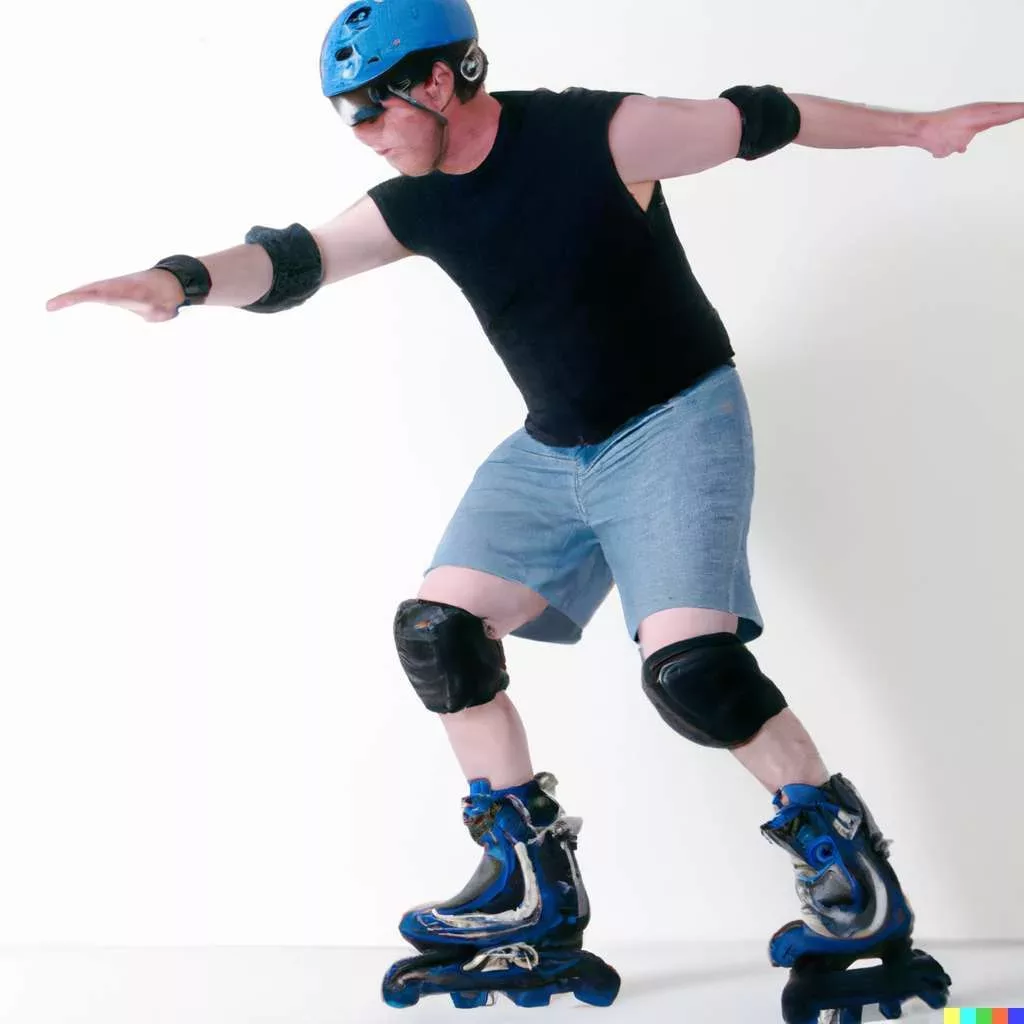Table of Contents
Table of Contents
If you’re eager to pick up the pace and master the art of rollerblading, I’ve got some great news for you.
I’ve rounded up 12 practical tips to help you accelerate your learning curve and become a bona fide rollerblading pro in a jiffy.
SULIFEEL Rainbow Unicorn Knee Pads for Kids Knee Elbow Pads Wrist Guards with Drawstring Bag Adjustable Protective Gear Set for Girls Roller Skating Bike Cycling Skateboard Scooter
$29.99 (as of 07/03/2024 12:37 GMT +01:00 - More infoProduct prices and availability are accurate as of the date/time indicated and are subject to change. Any price and availability information displayed on [relevant Amazon Site(s), as applicable] at the time of purchase will apply to the purchase of this product.)Follow these twelve tips to help you learn rollerblading quicker and stay safe
It can be tough to teach yourself how to rollerblade at the very beginning, and you may find that you learn a lot more quickly if you have some professional help.
A good trainer can show you the basics and help you avoid common mistakes.
They can also give you feedback on your progress and offer tips for improvement.
However, if this is unaffordable you should:
Start by learning how to stand on rollerblades
This will give you a solid foundation before moving on to more difficult manoeuvres.
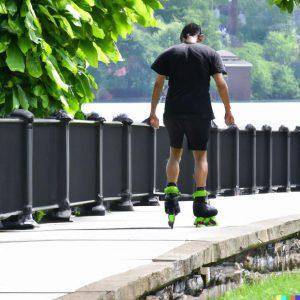
To do this, put on your skates and stand with one foot in front of the other.
Keep your knees bent and your back straight. Once you feel comfortable, try taking a few steps forward.
Use a wall or railing to help you balance on your rollerblades at first
If you’re just starting out learning how to rollerblade, you may find it helpful to use a wall or railing for support.
This will give you something to lean on if you start to feel unsteady, and can help you keep your balance.
Once you’re confident in your ability to stay upright, you can gradually begin to explore your skating skills without the need for support.
Sowume Adjustable Roller Skates for Girls and Women, All 8 Wheels of Girl's Skates Shine, Safe and Fun Illuminating for Kids
$59.99 (as of 07/03/2024 12:37 GMT +01:00 - More infoProduct prices and availability are accurate as of the date/time indicated and are subject to change. Any price and availability information displayed on [relevant Amazon Site(s), as applicable] at the time of purchase will apply to the purchase of this product.)Once you start getting the hang of rollerblading, you should practice for 1-2 hours daily.
If you’re serious about learning how to rollerblade quickly, you’ll need to put in some effort every day.
Practising for 1-2 hours will help you get the hang of it faster and make progress more quickly.
Start Skating But At a Low Speed
It’s always a good idea to start skating at a low speed.
This will help you get used to the feeling of being on rollerblades, and it will also help prevent you from getting injured.
As you get more comfortable with skating, you can gradually increase your speed.
Learn how to brake
Learn how to brake, seriously once you get moving, if you don’t know how to stop your skating journey could end up in disaster.
There are three main ways to stop or slow down.
- Once you are moving turn the toe point of the skates inwards forming a “v” shape, this will slow you down gradually and eventually bring you to a stop. If you are going at quite a pace turn the skates in then turn them back to a straight line and repeat, this will prevent a fall from an abrupt stop.
- Slide one skate behind the other and turn the skate that is behind 90 degrees, whilst keeping your weight forward apply pressure to the behind skate, the more pressure you apply the quicker you will stop.
- Use the built-in brake stop on the skate, bring your foot forward and tilt upwards to apply the brake, bend your knees and keep your weight forward.
OutdoorMaster Skateboard Cycling Helmet-Beetles Snug,Bike Helmet for Adults, Youth & Kids-Two Removable Liners Ventilation Multi-Sport Commuter Scooter Roller Skate Inline Skating Longboard
$19.99 (as of 07/03/2024 12:37 GMT +01:00 - More infoProduct prices and availability are accurate as of the date/time indicated and are subject to change. Any price and availability information displayed on [relevant Amazon Site(s), as applicable] at the time of purchase will apply to the purchase of this product.)Take breaks from skating as needed and don’t push yourself too hard
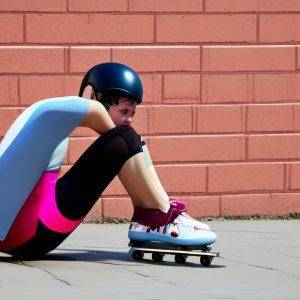
Rollerblading can be a fun and challenging way to get exercise, but it can also be dangerous if you’re not careful.
In order to reduce the risk of injury, it’s important to start out slowly and take breaks as needed.
Don’t try to push yourself too hard – rollerblading should be enjoyable, not exhausting!
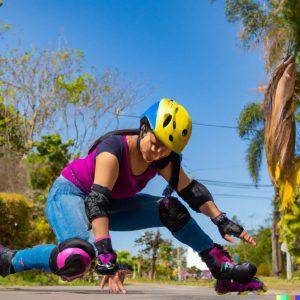
Don’t Be Afraid to Fall When You First Start Skating
When you first start out skating you’re bound to take a fall and it’s going to hurt to some degree but how much it hurts will depend on how you fall.
Always try not to fall backwards, if you feel yourself going, bend your knees and fall forwards and to the side.
Wear the appropriate Skating clothing and gear while you’re learning.
You should always wear the appropriate skating clothing and gear while you’re learning. This includes items like a helmet, gloves/wrist guards, elbow pads, and knee pads.
Wearing the right gear will help protect you from injury if you do happen to fall.
Wemfg Kids Protective Gear Set Knee Pads for Kids 3-14 Years Toddler Knee and Elbow Pads with Wrist Guards 3 in 1 for Skating Cycling Bike Rollerblading Scooter
$17.98 (as of 07/03/2024 12:37 GMT +01:00 - More infoProduct prices and availability are accurate as of the date/time indicated and are subject to change. Any price and availability information displayed on [relevant Amazon Site(s), as applicable] at the time of purchase will apply to the purchase of this product.)Watch Out for Cracks, Uneven Pavement, and Other Hazards
One of the most important things to keep in mind when rollerblading is to watch out for hazards.
Cracks, uneven pavement, and other obstacles can be dangerous, so it’s important to pay attention to your surroundings. If you’re skating in an area with a lot of traffic, stay aware of cars and other potential dangers.
Get a Good Pair of Rollerblades
When you’re first starting out, it’s important to get a good pair of rollerblades.
Cheap rollerblades are like to be slow and cumbersome and you are more likely to give up.
Look for a pair of skates that fit well and feel comfortable.
It’s also a good idea to look for skates with adjustable straps – this will allow you to tighten or loosen the skates as needed so that they always feel comfortable.
Try hiring skates at first to find a pair that suits you.
There are a few different brands of Rollerblades that are popular among beginners. Some of the most common brands include K2 Skates and Impala Skates.
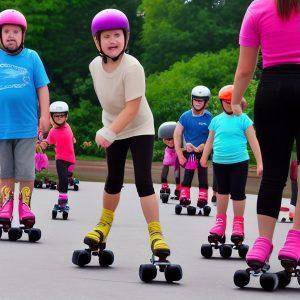
Practice Rollerblading With a Friend
Rollerblading is a great social sport/hobby practising with a friend will make it more enjoyable and you can pick up tips from one another.
It’s also a good idea to have someone with you in case of an emergency.
If you’re rollerblading in a park or on a trail, be sure to let someone know where you’re going and when you’ll be back.
Fun Roll Beginner Roller Skates by Roller Derby, Adjustable Sizing, Skates for Kids, Boys, Girls
$35.49 (as of 07/03/2024 12:37 GMT +01:00 - More infoProduct prices and availability are accurate as of the date/time indicated and are subject to change. Any price and availability information displayed on [relevant Amazon Site(s), as applicable] at the time of purchase will apply to the purchase of this product.)How Quickly Can I Improve My Skating
This will depend on your dexterity and the time you put into learning.
Try different techniques to find what works best for you
Stay focused and stay positive while learning
In conclusion, rollerblading can be a fun and exhilarating experience, but it is important to take the necessary precautions when learning how to do it.
By following the tips mentioned in this post, you should be able to learn how to rollerblade faster while minimizing your chances of getting injured. Have fun and stay safe!
Conclusion
The tips and tricks provided in the article are designed to help beginners get started and quickly improve their rollerblading skills.
Whether you are looking to simply enjoy rollerblading as a recreational activity or pursue it as a competitive sport, this article is an excellent resource to get you started. So if you’re ready to take your rollerblading skills to the next level, be sure to give this article a read!
Are the Roller Skating Tricks for Beginners Also Helpful for Learning Rollerblading?
Roller skating tricks for beginners can indeed be helpful when learning rollerblading. Many basic skills and techniques, such as maintaining balance, proper body posture, and footwork, are transferable between the two activities. Mastering these tricks builds a solid foundation, enabling beginners to gradually progress and skillfully maneuver on rollerblades as well.
How Can I Learn Rollerblade Tricks Faster?
Learning rollerblade tricks for skating enthusiasts can be a thrilling journey. To speed up your progress, focus on mastering the basics first. Strengthen your balance and control by practicing fundamental maneuvers like turning and stopping. Then, gradually progress to more advanced tricks, such as jumps and spins, by breaking them down into manageable steps. Above all, dedication, patience, and consistent practice will pave the way for faster improvement in your rollerblade repertoire.
Related Questions from Quora
Is it appropriate to learn inline skating at 30’s years of age?
Yes! Inline skating is a great way to get exercise, and it’s never too late to start learning.
How can I learn to roller skate?
There are many ways that you can learn to roller skate. You can take classes, watch instructional videos, or practice on your own.
How long does it take to learn how to roller skate?
It takes a few hours to learn the basics of roller skating. After that, it depends on how often you practice and how good you want to get.

